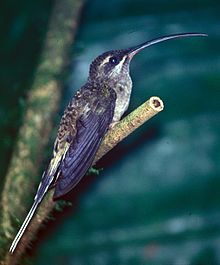- Long-billed Hermit
-
Long-billed Hermit 
Photographed in Drake Bay, Costa Rica Conservation status Scientific classification Kingdom: Animalia Phylum: Chordata Class: Aves Order: Apodiformes Family: Trochilidae Genus: Phaethornis Species: P. longirostris Binomial name Phaethornis longirostris
(Delattre, 1843)The Long-billed Hermit (Phaethornis longirostris) is a large hummingbird that is a resident breeder from central Mexico south to northwestern Colombia, extreme western Venezuela and western Ecuador. This species is currently (2006) known as the Western Long-tailed Hermit, but it is likely, following recommendations from Gary Stiles in February 2006, [1] that the new name will be officially adopted by most authorities.
The taxonomy of this group is complicated, with similar hermit populations from both sides of the Andes being originally named as one species, the Long-tailed Hermit, P. superciliosus. The latter name in now reserved for the species east of the cordillera.
A further problem is the potential separation of the paler, greyer, and slightly smaller southern subspecies P. l. baroni as Baron’s Hermit, P. baroni, although the opposition of Stiles makes that split unlikely to be formally accepted unless confirmed by further research[2].
The Long-billed Hermit inhabits forest undergrowth, usually near water and its preferred food plants. It is 15 cm long and weighs 6 g. The bill is very long and decurved (3.4-3.7 cm), with a red upper and black lower mandible, and the central feathers of the tapered tail are long (6.3-6.8 cm) and white-tipped.
The adult Long-billed Hermit is mainly dark green above with a blue-green rump. It has a dark mask through the eye, with buff stripes above and below this, and a brown face. The underparts are grey to buff in colour. The sexes are similar, although the female is slightly smaller, but young birds have buff fringes to the feathers of the upperparts and head.
During the breeding season, male Long-billed Hermits sing in communal leks of up to 25 birds, and also wiggle their long tails in display. Competitive lek singing can occupy half of the daylight hours, the purpose of course being to attract females. The female selects the best lek singer to mate with. The song consists of high pitched squeaky of chink churr and shree sounds. The flight call is a high sweep.
The female Long-billed Hermit is solely responsible for nest construction, incubation and feeding the young. She lays two white eggs in a conical nest of fibres and cobwebs suspended under a large Heliconia or banana leaf 1.2 to 1.5 m above the ground. The incubation period is 14–19 days, with another 18 to 28 days to fledging.
The food of this species is nectar, taken from large flowers, such as Heliconias and passion flowers, and small insects and spiders taken as an essential source of protein. Hatchlings are fed by the female with regurgitated invertebrates.
Long-billed Hermits are trap-line feeders; they do not defend territory, but visit seasonal flowers on routes through the forest up to 1 km long. They pollinate some flowers such as Aphelandra which have long flowers adapted to the hummingbirds long curved bill.
References
- BirdLife International (2004). Phaethornis longirostris. 2006. IUCN Red List of Threatened Species. IUCN 2006. www.iucnredlist.org. Retrieved on 05 May 2006. Database entry includes justification for why this species is of least concern
- Hilty, Birds of Venezuela, ISBN 0-7136-6418-5
- Stiles and Skutch, A guide to the birds of Costa Rica ISBN 0-8014-9600-4
External links
- ^ "Proposal (#205) to South American Classification Committee". http://www.museum.lsu.edu/~remsen/SACCprop205.html. Retrieved 2006-03-11.
- ^ "Proposal (#136) to South American Classification Committee". http://www.museum.lsu.edu/~remsen/SACCprop136.html. Retrieved 2006-03-11.
- Long-billed Hermit videos, photos & sounds on the Internet Bird Collection
- Long-billed Hermit photo-High Res; Article AOCR
Categories:- IUCN Red List least concern species
- Phaethornis
- Hummingbird species of Central America
- Birds of Mexico
- Birds of Colombia
- Birds of Ecuador
- Birds of Venezuela
- Hummingbird species of South America
Wikimedia Foundation. 2010.



